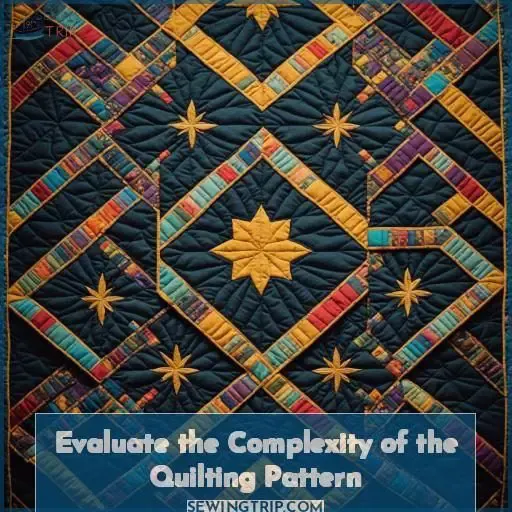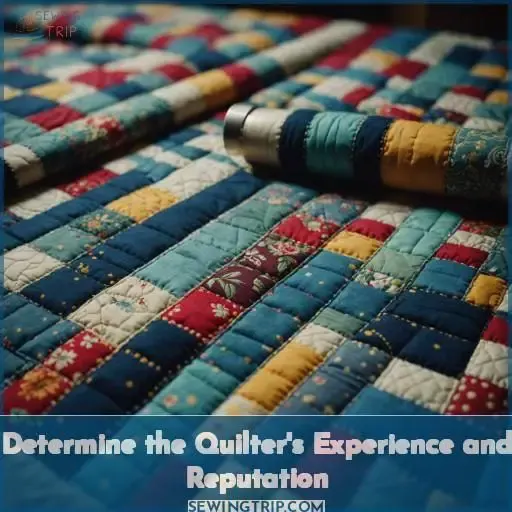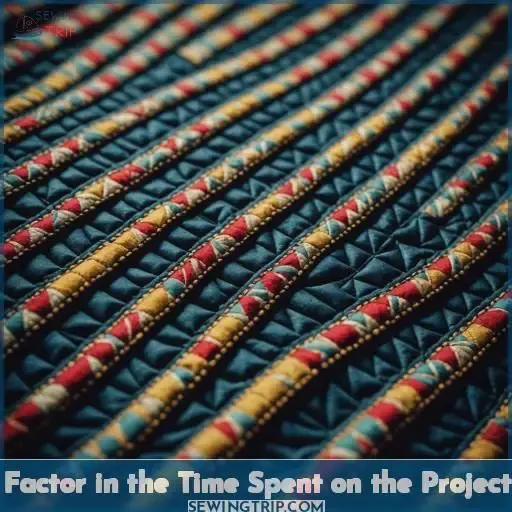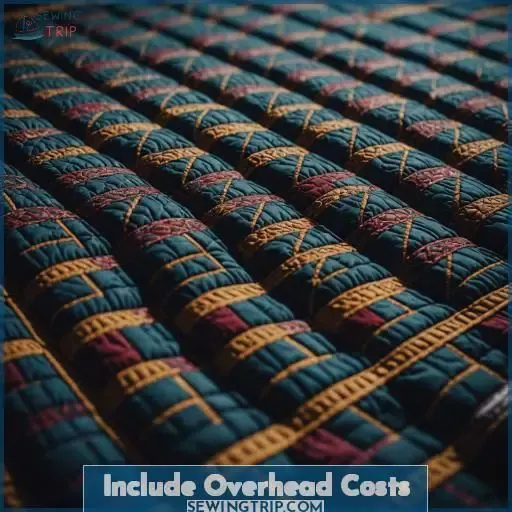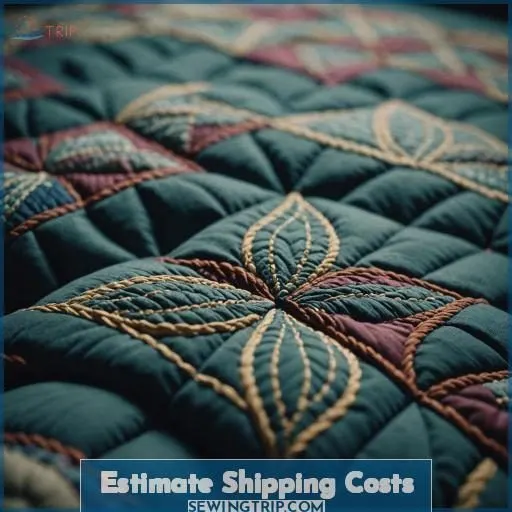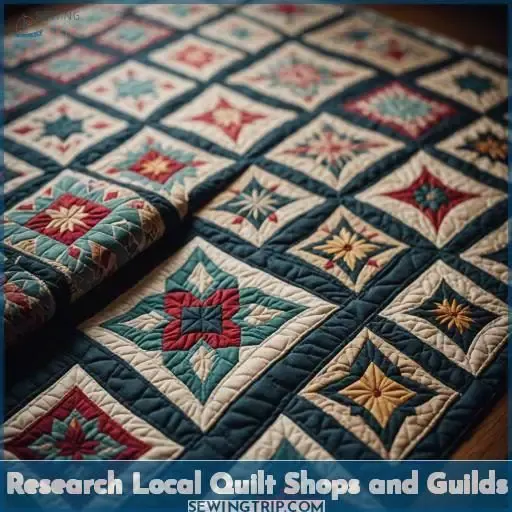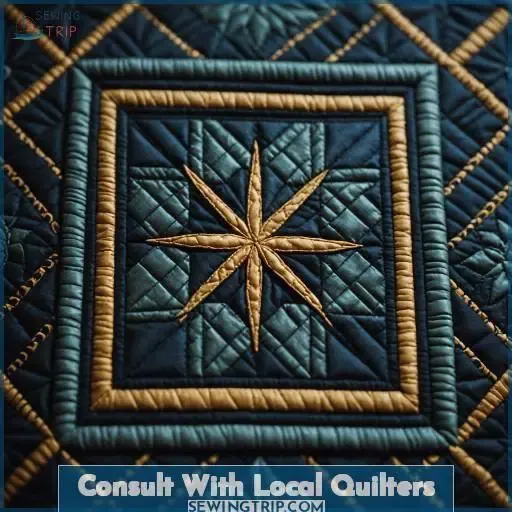This site is supported by our readers. We may earn a commission, at no cost to you, if you purchase through links.
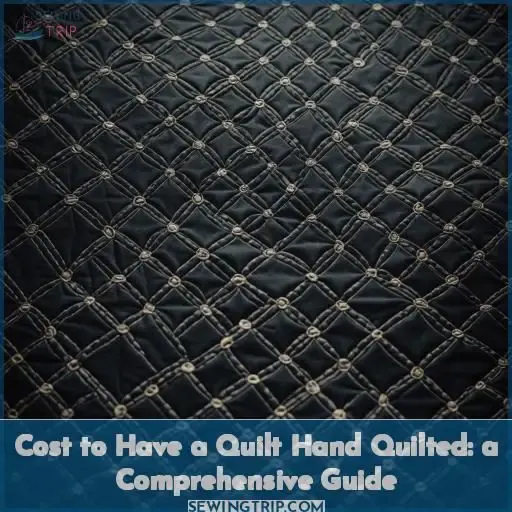
The cost of having a quilt hand-quilted can vary greatly, but generally ranges from $0.50 to $5 per square inch. The key factors that influence the price include the size of the quilt, the complexity of the quilting pattern, the experience and reputation of the quilter, and the materials used.
Quilters with more training, guild memberships, and a strong reputation will typically charge higher hourly rates, while those just starting out may offer lower prices. Considering the quilter’s expertise and the intricacy of the design are essential in determining the final cost.
Table Of Contents
- Key Takeaways
- How Much Does It Cost to Have a Quilt Hand Quilted?
- Determine the Cost of Hand Quilting
- Consider the Size of the Quilt
- Evaluate the Complexity of the Quilting Pattern
- Determine the Quilter’s Experience and Reputation
- Calculate the Materials Used
- Factor in the Time Spent on the Project
- Include Overhead Costs
- Estimate Shipping Costs
- Research Local Quilt Shops and Guilds
- Consult With Local Quilters
- Frequently Asked Questions (FAQs)
- Conclusion
Key Takeaways
- The cost of hand quilting can vary greatly, with prices ranging from $0.50 to $5 per square inch.
- Key factors influencing the price include the size of the quilt, the complexity of the quilting pattern, the quilter’s experience and reputation, and the materials used.
- The cost can also vary based on the quilter’s training, guild membership, and reputation, as well as the quilting density and complexity.
- When determining the cost of hand quilting, consider various pricing models such as per spool of thread, per square inch, hourly wage, or flat rate based on quilt size.
How Much Does It Cost to Have a Quilt Hand Quilted?
The cost to have a quilt hand quilted can range from $200 for a crib size to between $500 and $1,000 for a queen size, with some quilters charging up to $1,500 based on the intricacy and size. Prices may vary by region, and it’s recommended to get local quotes for the most accurate pricing.
Determine the Cost of Hand Quilting
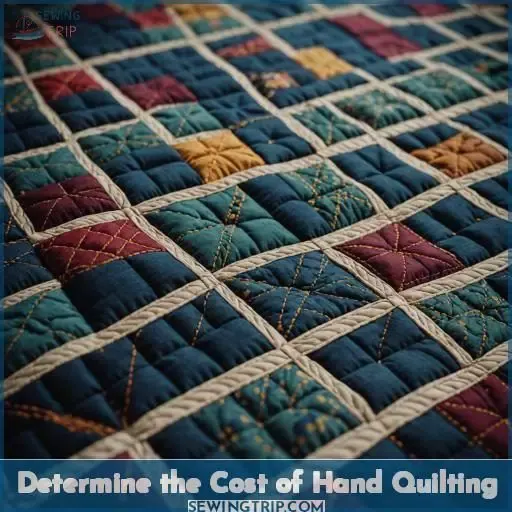
To determine the cost of hand quilting, consider various pricing models such as per spool of thread, per square inch, hourly wage, or flat rate based on quilt size. The cost can vary by region, quilter’s experience and reputation, and quilting density and complexity.
Assess the skill of the quilter and factor in overhead expenses. Remember, handmade quilts are priceless and can be a valuable investment, so the cost should reflect the time, materials, and expertise involved in the quilt-making process.
Consider the Size of the Quilt
The size of the quilt is a pivotal factor in ascertaining the cost of hand quilting. The cost per square inch can vary considerably contingent upon the quilter’s expertise and standing, as well as the closeness and intricacy of the quilting pattern.
Cost Per Square Inch
Diving into the heart of quilt pricing, the cost per square inch is your golden ticket to understanding the financial landscape of hand quilting. It’s where size variations meet the nitty-gritty of hourly rates and material differences.
Ever wondered, How much does it cost to have a quilt hand quilted? Well, it’s a dance of quilt design, materials, and those sneaky shipping estimates that can sway the final tally.
Quilters Experience and Reputation
To determine the cost of hand quilting, consider the quilter’s training, guild membership, and reputation. Their experience and skills development will impact the hourly rate they charge. Additionally, the quilter’s reputation can influence the demand for their work. When marketing your quilt, highlight these factors to showcase the value of your commission.
Quilting Density and Complexity
Evaluating the dimensions of your quilt is essential when calculating the cost of manual quilting. Here are five factors to ponder:
- Fabric choice: The kind of fabric employed can influence the overall expense and intricacy of the quilt.
- Machine vs manual quilting: Manual quilting often requires more time and effort, which can inflate the cost.
- Traditional vs contemporary patterns: Traditional patterns might demand more complex quilting, whereas contemporary designs can be simpler.
- Customized vs pre-existing designs: Customized designs can be more expensive due to the time and effort needed to create them.
- Quilt as artwork: If your quilt is more akin to a work of art than a practical item, it may be priced higher due to its unique value.
Evaluate the Complexity of the Quilting Pattern
Assessing the intricacy of a quilt’s design is essential when determining the price of hand quilting. The complexity of the pattern, fabric choice, thread quality, batting thickness, and individual preference all have an impact on the overall cost.
A simple design may necessitate fewer materials and less time, while a more elaborate pattern may demand more fabric, thread, and batting.
Furthermore, the quilter’s experience and reputation can also influence the cost, as a more experienced quilter may charge more for their expertise.
By taking these factors into account, you can better understand the price of having a quilt hand quilted.
Determine the Quilter’s Experience and Reputation
Determining the quilter’s experience and reputation is a vital aspect of pricing a handmade quilt. The quality of a quilt is directly related to the skill and expertise of the quilter. A quilter with a distinguished reputation for producing high-quality quilts can demand a higher price for their work. Time constraints also play a role in the cost, as experienced quilters can often complete a project more quickly than those with less experience.
When considering the hourly rate for a quilt, it’s imperative to remember that quilting is a skilled trade that requires time and dedication. A skilled quilter should be remunerated for their time and expertise. Regional pricing can also affect the cost, as quilters in different areas may have varying costs of living and overhead expenses.
When determining the cost of a handmade quilt, it’s paramount to take into account the materials used, the time spent on the project, and the quilter’s experience and reputation. A quilt made by an experienced and reputable quilter will often be more costly than one made by a less experienced quilter, even if the materials are the same.
Calculate the Materials Used
Calculating the materials used in hand quilting isn’t just about numbers; it’s about weaving dreams into reality. Here’s what you’ll need:
- Fabric Requirements: Immerse yourself in your design and measure twice, cut once. You’ll need fabric for the top, back, and binding.
- Fabric Cost: Quality over quantity! Opt for high-quality fabric that won’t fade or pill.
- Thread Requirements: Choose a thread that’s strong yet subtle, becoming the silent hero of your quilt.
- Needle Size and Batting Type: The right needle size makes a world of difference, as does selecting the perfect batting for warmth and comfort.
Factor in the Time Spent on the Project
Factoring in the time spent on a quilting project is essential when determining the cost of hand quilting. The quilter’s skill level, project size, and pattern complexity all play a significant role in the time required to complete a quilt. As a quilter, you must consider your own hourly rate, which can vary depending on your experience and reputation. For example, if you charge $20 per hour and spend 20 hours on a quilt, your total charge for your time would be $400.
It is also essential to account for the time spent on additional tasks such as cutting and piecing the quilt top, quilting the quilt, and any necessary repairs or customizations. You may choose to charge different hourly rates for various steps in the process, depending on the complexity of the task and your comfort level with charging your clients.
Include Overhead Costs
As a quilter, it’s essential to take into account overhead costs when pricing your work. If you’re selling wholesale, these costs are typically covered by the buyer. However, if you’re selling retail, you’ll need to factor in overhead costs like rent, utilities, and marketing expenses.
You might consider setting a fixed rate per square foot or establishing an online shop to simplify the pricing process. Remember, overhead costs can vary greatly depending on your location and the size of your operation.
Estimate Shipping Costs
Estimating shipping expenses for a hand-quilted quilt necessitates considering several aspects, including package weight, shipping rates, shipping options, and regional shipping costs. The expense of shipping a quilt can fluctuate widely depending on these factors, so it’s imperative to research and plan accordingly.
When shipping a quilt, the weight of the package plays a significant role in determining the shipping cost. USPS usually charges based on weight and zone, so understanding the impact of weight on pricing is important, especially if you have an e-commerce business and need to set shipping costs. For example, a 1-pound package might cost around $8.70, while a 2-pound package could cost $9.25.
Shipping rates also vary based on the shipping speed you choose. The standard Priority Mail service may not be fast enough for some, so you might need to consider the Priority Mail Express service, which costs more but offers faster delivery.
Regional shipping costs can also affect the overall shipping cost. If you’re shipping a quilt across the country, you might need to consider using a shipping carrier that provides online tracking and accountability, such as FedEx or UPS.
To estimate shipping costs for your hand-quilted quilt, you can use shipping rates by weight charts provided by shipping companies like USPS. These charts help you determine the price based on the weight and destination of your package.
Additionally, you can consider using flat rate boxes, which can be a cost-efficient option for shipping quilts. These boxes have a fixed price, regardless of the weight of the contents, and can help you save money on shipping costs.
Remember to insure the contents of the box for their full value, especially if the quilt is valuable. This will help ensure that you’re compensated for the full amount in case of loss or damage during shipping.
Research Local Quilt Shops and Guilds
To get a better understanding of the local quilting scene and potential cost differences, research local quilt shops and guilds. These groups often have a wealth of knowledge about quilting costs in your region. They may also offer discounts for quilting group members or provide recommendations for skilled quilters.
Don’t forget to inquire at churches for quilting groups, as many communities have these groups that meet regularly. By engaging with these local resources, you’ll be able to gain valuable insights into the quilting community and the costs associated with hand quilting in your area.
Consult With Local Quilters
To understand the cost of hand quilting, it’s important to examine several factors. Firstly, assess the quilt’s size, which can affect the cost per square inch and the quilter’s expertise and reputation. The quilting density and intricacy** should also be taken into account, as these elements can determine the time spent on the project.
When consulting with local quilters, you can gain valuable insights into the regional quilt styles and the availability of nearby quilt exhibitions. Quilting cooperatives and local quilt groups can provide a wealth of information on quilt makers’ rates and the time required for various quilting techniques. These resources can help you make informed decisions about the cost of your hand quilted project.
For example, you might find that a simple echo quilting pattern costs between $200 and $400, while more intricate quilting patterns could range from $500 to $1,000. These estimates can vary depending on the quilter’s experience, the complexity of the pattern, and the materials used.
Frequently Asked Questions (FAQs)
How does thread quality affect quilting costs?
You know the old saying, You get what you pay for. With quilting, premium thread costs more upfront, but it glides through the fabric like butter, saving you time and money in the long run.
Are there discounts for multiple quilt orders?
Absolutely, many quilters offer discounts for bulk orders – it’s their way of saying the more the merrier! Knock 10-20% off for 3 or more quilts. Just let ’em know you’re a volume buyer.
What payment methods do quilters accept?
Quilters often accept cash, checks, PayPal, or credit cards for commissioned work. Some may offer discounts for bulk orders or payment plans to accommodate varying budgets. Be sure to discuss payment terms upfront to avoid any surprises.
Is there a warranty on quilting services?
You bet there’s a warranty on quilting services! Most professional quilters offer a satisfaction guarantee, so you can feel confident your masterpiece will be returned in pristine condition. Just ask about their policies when getting a quote.
Can quilting services be expedited?
Expedited quilting services are as swift as a falcon, allowing you to get your heirloom quilt back in record time. Whether you need it in a week or two, the skilled quilters can accommodate your timeline, no sweat.
Conclusion
Ultimately, having a quilt hand-quilted can cost anywhere from $0.50 to $5 per square inch. The key factors impacting the price are the quilt’s size, the complexity of the quilting pattern, the quilter’s experience and reputation, and the materials used.
By thoughtfully considering these elements, you can find the ideal quilter to realize your vision at a reasonable price.
Regarding the cost of hand quilting a quilt, this detailed guide offers the necessary information.


